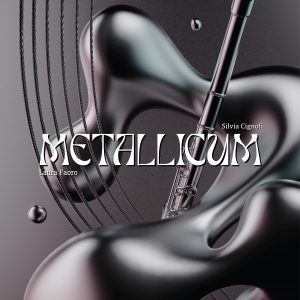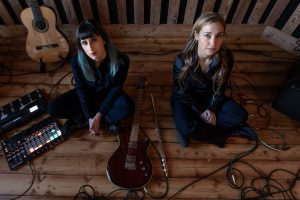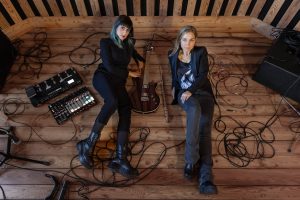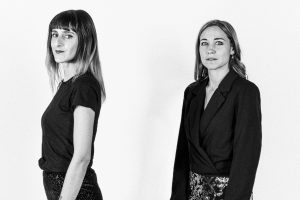
M E T A L L I C U M
Laura Faoro, flutes
Silvia Cignoli, guitars
February 2024 is dedicated to the new project M E T A L L I C U M for processed flutes, electric guitar and electronics, in duo with the guitarist Silvia Cignoli.
Which new musical worlds can processed flute and electric guitar open up?How can contemporary and electronic music “inhabit” a museum space? And – vice versa – how can the suggestion arising from a design object such as an iconic Cimbali machine be transformed into music?
Thanks to the Life is Live call by Smart – Fondazione Cariplo (that selected the project), I will propose METALLICUM with Silvia next February in a new format, connected with the four brand new museum spaces in Milan and the surrounding area that will host it. In fact, the initiative includes a series of activities open to all ages, in close dialogue with the collections and the places that host them, involving participants personally in an unprecedented musical and synaesthetic experience.
The calendar:
- February 4th, 2024, House of the Custodian of the Waters, Vaprio d’Adda
- February 10th, 2024, ADI Design Museum, Milan
- February 18th, 2024, MUMAC – Cimbali Group Coffee Machine Museum, Binasco
- February 20th, 2024, NoMus – Center for Studies and Research on 20th century and contemporary music, Milan
Each appointment includes an INTERACTIVE WORKSHOP from 2pm starting from the experience of discovering each museum space and lasting a couple of hours. Designed for a non-specialist audience, the workshop focuses on the conception and creation of an electronic audio track inspired by one or more objects, produced through a sound processing similar to that used by musicians in concert, but easier and more user friendly. Participants, invited to explore the exhibition rooms, will be introduced to the world of Sound Processing through practical exercises of listening and synesthetic translation of images and objects, in order to become protagonists themselves and creators of their own music inspired by the visit experience of the museum. Voice, body sounds, electronic objects, cell phones will be used.
No specialist skills are required to participate, and the presence of young and very young participants is particularly welcome.There is a maximum limit of 15 active participants, upon reservation.
After the workshop, a CONCERT by the Faoro-Cignoli duo is scheduled – around 6pm – which offers a journey into the musical world of processed flutes, electric guitar and electronics, intertwining the innovative sounds of the new recording project “M E T A L L I C U M”, which will be published (in physical and digital format) by the Italian label Stradivarius, leader in the field of contemporary music in collaboration with AGON. Access will be free.
Due to the fact that we want to propose an unprecedented anthology for flute and electric guitar, between classical music, electronics and instant improvisation, we wish to make our project known to an ever-increasing audience, of different ages and outside the classical circuits of enthusiasts, making them consciously participate in the musical world that we propose. Therefore we thought of presenting our project as a concert, but associating it with a new type of workshop, strictly based on the concepts of cross-media and synesthesia and connected with the museum spaces that will host us.
Our goal is threefold: to bring the public closer to our musical product, making them experience the sound processing work first-hand; invite the public to discover young and innovative museum spaces; dedicate post-production work to the soundtracks created during the workshop, so that they can remain as evidence for the museum itself.

THE MUSICAL PROJECT
Flute and guitar were born as acoustic instruments, which use very simple actions to produce sound: the flute is linked to breathing, the guitar to the plucking of the strings. Yet with electronics and new technologies the two instruments are transformed and the possibilities expand, opening the way to soundscapes full of contemporary connections. METALLICUM musical project therefore aims to explore the points of contact, the frictions and the intersections between electric flute, electric guitar and electronics, with the desire to make this particular duo a hybrid, an “augmented sound object”, capable of synchronizing acoustic elements and electronic transformations from a perspective that transcends musical genres. We want to propose an unprecedented anthology for flute and electric guitar, between classical music, electronics and instant improvisation, and we wish to make our project known to an ever-increasing audience, of different ages and outside the classical circuits of enthusiasts, making them consciously participate in the musical world that we propose.
THE WORKSHOP
Just as the processed flute and guitar become bearers of a contemporary poetic languagevthat want to give them a different, unprecedented and anti-rhetorical voice, so the workshop proposes listening and practicing exercises that can allow the user to experience the same creative process which passes through the musicians and their music, giving them an extended look at the meaning of artistic creation. Museum spaces thus become a score in progress, a creative scape containing sonic, visual or tasting events, a source of new imaginative “scores”.
THE CONCERT
The concert will therefore be an opportunity to listen to a selection from this anthology: regarding the Italian authors, Zone I by Maurizio Pisati in an unreleased version, Dogma #2 by Filippo Del Corno and Walks on Devil’s Talk, unreleased by the young Luca Donati, winner of the call for scores announced in 2023 for this new recording project. The program will be completed by WAVE by the young American composer Baldwin Giang, winner of the Prix de Rome 2023, Elegy of Suspended Energy by Silvia Cignoli, and Argues – Cassandra with Siri by Ying Wang.

THE MUSICIANS
Laura Faoro, specialized in contemporary repertoire; awarded with two consecutive Stockhausen Prizes (2019 and 2022) and winner of the 2023 Donatella Giudici Culture Prize awarded to her by NoMus, she carries out a rich international musical and performative activity. For ten years she has been the author of intermedial projects aimed at valorising contemporary music in its interconnections with other performing arts, which have received various musical and theatrical awards. www.laurafaoro.it
Silvia Cignoli is a classical, electric guitarist and composer. She plays as a performer and author of her own works, in contemporary, classical and experimental music festivals and for audiovisual festivals, also dedicating herself to music for images. He released the albums “The Wharmerall”, “Digital Memories From a Suspended World” and “Shimmering Behavior”. www.silviacignoli.com

The project had its first genesis in 2017, focusing on recently composed pieces (Garnero, Di Maggio, Abram, Jacobs), to continue with works born within Giovanni Verrando’s electronic music laboratory. We also explore two soundscapes curated by the musicians themselves, Silvia Cignoli and Laura Faoro.
2017 Program:
Chiara Carretti, La chanson du robot for flute, prepared acoustic guitar and electronics
John Abram (1959*), The rocky moon (V – cut version), for flute and prepared classic guitar
Gabriele Batia, Mute tracks for flute and electronics
Dan di Maggio (1969*), Arnold’s Dream for bass flute and electric guitar. Premiere.
L’acqua non ricorda, soundscape by Silvia Cignoli
Fernando Garnero (1976*), Interlude for electric guitar and objects
Qualcosa che si sa che non c’è, ambiente sonoro soundscape by Laura Faoro
Bryan Jacobs (1979*), Syncro-vox and other cheap animation techniques for alto flute, electric guitar and electronics
The usual flute and guitar duo is proposed again in a new contemporary key, a kaleidoscope of possibilities that investigate various possible combinations, with the help of technology, from amplification to sound processing. At the opening a piece by C. Carretti, a pupil of Giovanni Verrando, who literally dismantles the flute and plucks an acoustic guitar to give life to the “Chanson du Robot”, the lament of a robot who, at the sight of two girls, would like to become human, and reflects on how humans instead spend their lives wanting to mechanize it. Following it there is an excerpt from the suite “The Rocky Moon” by J. Abram, a piece whose title makes an oblique reference to the Rococo period and to the difficulty that arises, looking at some photos of the moon, in distinguishing the craters from the mountains, as well as in some sections of the passage, the distinction between downbeat and upbeat will be dubious. “Mute Tracks” by G. Batia, a pupil of Giovanni Verrando, cites Chaplin in electronics and investigates the flute possibilities in merging silent phonemes with real sounds, in a strict dialogue with the electronic track, within a rhythmically relentless structure. “Arnold’s Dream” by D. di Maggio is based on chordal materials taken from the Serenade op. 24 by Arnold Schoenberg in which the author, a pioneer for the time, had already introduced the guitar into the ensemble, and on some proto-serial elements: a composition (also intended to be playful and amused, but not irreverent), which alludes to a sort of curious premonitory dream of the composer. “L’acqua non ricorda” (Water does not remember) is the first of the two soundscapes presented tonight, curated by Silvia Cignoli, with sound materials chosen using the rhythmic effects of a small vintage keyboard whose sounds are filtered through fuzz and reverb effects, added to the sounds of the guitar electric, looped, overlapped, filtered and then dismissed. “Interlude” by F. Garnero follows, a piece that explores a range of noises obtained by rubbing the electric guitar with some objects. “Qualcosa che si sa che non c’è” (Something you know isn’t there) edited by L. Faoro is a soundscape that investigates the percussive and vocal possibilities of the flute when enhanced by sound processing and, in trying to transform the flute into something that perhaps isn’t there, plays on phonetic assonances that refer to the title. The program ends with “Syncro-vox and other cheap animation techniques” by B. Jacobs, a piece for which the author created a scrolling video reading system with live audio processing, in which the musicians are, alternately, free to improvise on sound materials indicated by the composer or strictly synchronized on rhythmic gestures. In electronics there is the silent drum, a digital processing tool invented by Jaime.
